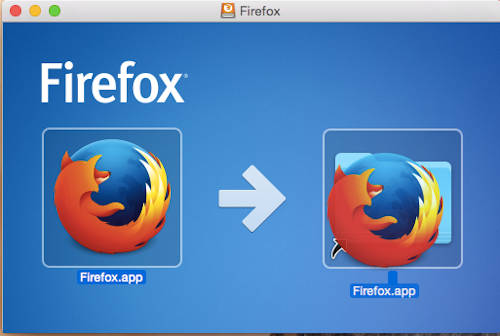Mac OS FAQ |
1. How do I install Applications?

To install application software, you need to have administrator rights in most
cases.The Mac will prompt you for administrator credentials when you try to install an application.
You can install applications by either:
a) A DMG (disk image) file.
i)
Open the image to find the application or an installer.
ii) Drag and drop the application to the Applications folder.
b) A PKG (package) file, which needs to be run to install the application and other files to the system.
c) Run a setup or installer program which needs to be run to extract and install the application.
d) A ZIP or SIT (Stuffit) archive which contains the Application, package or installer files.
e) A CD, DVD or USB which contains the application installation files.
Note, if you don't have Administrator rights, can can place your program in the Applications folder in your profile: \Users\username\Applications.
2. How do I uninstall applications?
To remove a application from your hard disk, you can do one of two ways:
a) Drag and Drop the application program from Applications folder to the Trash.
b) Run an uninstaller program to remove the Application and support files.
c) You can tidy up applications using the Manage Storage facility. Open About my Mac from the Apple menu, select Storage tab and then the Manage button to review where your storage is used.
Click on Applications on the left and here you can Remove applications and related files using this tool.
3. I cannot install or run some software, how do I check if its compatible?
Check the application's web site or the App Store for Hardware and software compatibility.
Older software such as PowerPC or 32-bit software may show a 'No entry' sign in the program icon to indicate that the program is not compatible with the version of macos you are running.
4. How do I check for updates for my applications?
Programs installed from the App Store, can also be updated via the App Store automatically. Open the App Store icon in the Dock and click on the Updates tab to check for new update.s
Many programs use different ways to check for updates:
* An option with in the program itself can be selected to check for any updates. For example,
* An Email notification may be sent by the company or author of the program E.g. Piriform CCleaner.
* Visiting the home page of the software in question and check the Support or Download pages for any new versions of the software.
5. How do I turn off app or application notifications, update reminders etc?
You can control notifications for programs via the System Preferences, Notifications settings and turn off any notifications for specific programs.
Some applicatios have built-in update checks and these can also be turn off, within the program.
6. I have installed a application, but unable to run it?
If an application has been downloaded from a site other than App Store and not from a recognised publisher, then Mac OS will block it by default. This is a feature of the Gatekeeper.
To unlock it, open System Preferences, select Security and Privacy, click on the padlock and and unlock the feature, select Allow apps downloaded from 'App store and identified developers',
and it may prompt to allow a recent application. It will ask 'The app name is an app downloaded from the Internet. Are you sure you want to open it?', click Open. See article HT202491 for more infromation.
If an application is for the PowerPC, it will not run on Intel Macintoshes. If it is a Universal application, it may run on both Power PC and Intel Macs running Mac OS upto v 10.6, as Rosetta was dropped from v10.7 (Lion).
Intel applications can run on Intel Macs for 32 bit and 64 bit from v10.4 (Tiger) until 10.14 (Mojave). Mac OS Catalina can only run 64 bit Intel applications.
MacOS 11, Big Sur, or later can run Intel and Apple Silicon (ARM) based applications.
Go to Patches and Updates